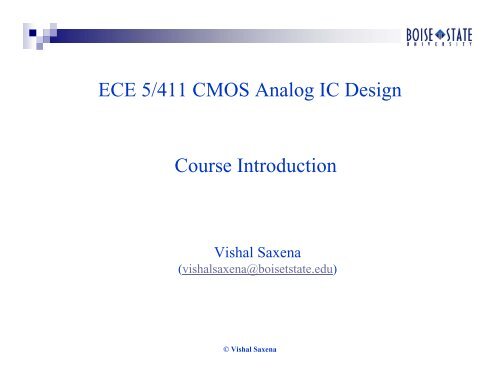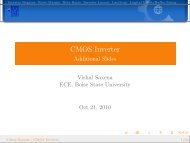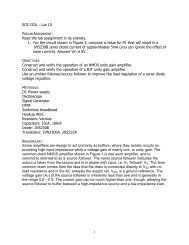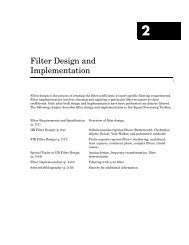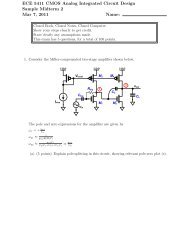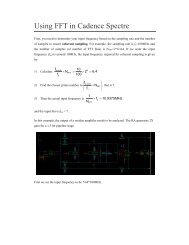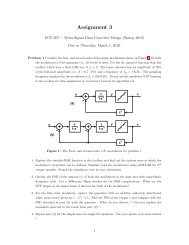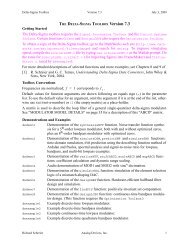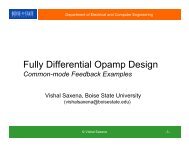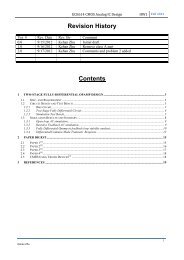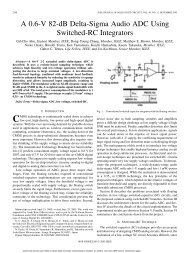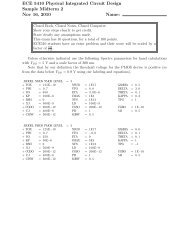ECE 5/411 CMOS Analog IC Design Course Introduction
ECE 5/411 CMOS Analog IC Design Course Introduction
ECE 5/411 CMOS Analog IC Design Course Introduction
Create successful ePaper yourself
Turn your PDF publications into a flip-book with our unique Google optimized e-Paper software.
<strong>ECE</strong> 5/<strong>411</strong> <strong>CMOS</strong> <strong>Analog</strong> <strong>IC</strong> <strong>Design</strong><strong>Course</strong> <strong>Introduction</strong>Vishal Saxena(vishalsaxena@boisetstate.edu)© Vishal Saxena
<strong>Course</strong> Outline Instructor : Vishal Saxena Time : Monday, Wednesday, 6:00-7:15 p.m. <strong>Course</strong> dates : Jan 19 – May 6, 2011. Location : MEC 206 Office Hours : Monday, Wednesday, 4:30-5:30 p.m. Holidays : March 28 & 30. Final Exam time: (Tentative) Monday, May 9, 2011, 6:00-8:00 p.m. <strong>Course</strong> TA : Sakkarapani Balagopal (Bala) Website : http://coen.boisestate.edu/ams/courses/ece5<strong>411</strong>/s11/<strong>ECE</strong>5<strong>411</strong>.htm© Vishal Saxena
<strong>Course</strong> Topics <strong>Analog</strong> Modeling Current mirrors Voltage references Negative feedback systems and stability Amplifiers, frequency compensation, opamps. PREREQ: <strong>ECE</strong> 5/410.© Vishal Saxena
Textbook and References <strong>CMOS</strong> Circuit <strong>Design</strong>, Layout andSimulation – R. J. Baker, 3nd Edition,Wiley-IEEE, 2010. For detailed references and handouts seethis page. Other references:© Vishal Saxena
<strong>Course</strong> Pedagogy, Grading and Policies Combination of lecture notes, slides and simulation Lecture notes will be posted online Additional slides, Matlab code etc will also be posted. Workload (Grading) Homeworks (20%): Weekly assignments. Midterm Exam1 (20%) Midterm Exam2 (20%) Project 1 (20%): Opamp design and characterization Final (20%) Policies No late work. Neither the final exam nor final project will be returned at the end ofthe semester. Plagiarism is not acceptable.© Vishal Saxena
Why <strong>Analog</strong> ? Real world is analog. Digital world: Discrete-time, discrete-amplitude signal representation. Interface circuits: ADC and DACs. High speed circuits are analog (Serial IOs, 60 GHz RF)© Vishal Saxena
<strong>Analog</strong> Circuits in Modern VLSI Systems <strong>Analog</strong> to digital conversion Digital to analog conversion Amplification <strong>Analog</strong> filters Signal processing circuits at high frequencies RF, Serial IO, etc. Power management-voltage references, voltage regulators Oscillators, PLL, DLL The last two are found even on many “digital” <strong>IC</strong>s© Vishal Saxena
System Level View Top-down approach is used in system design. Scope: Thesis/dissertation work.© Vishal Saxena
Block Level View Scope: Data converters, Advanced <strong>Analog</strong> courses.© Vishal Saxena
Circuit Level View-1 Scope: Advanced <strong>Analog</strong>, Active Filter <strong>Design</strong>, Mixed-Signalcourses.© Vishal Saxena
Transistor Level ViewVOutMM6VOutP In this course, we will deal with basics of transistor-levelanalog design.© Vishal Saxena


